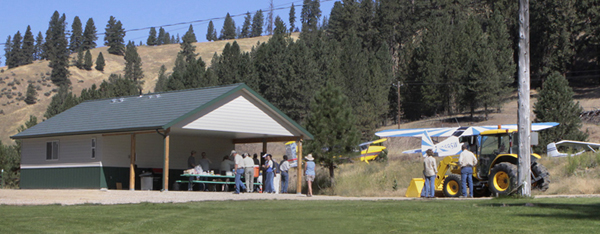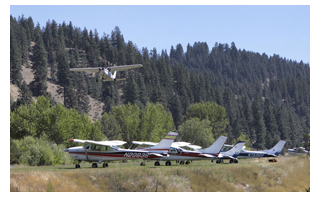
 Partnership opens new era of recreational airstrip enhancements
Partnership opens new era of recreational airstrip enhancements
A cooperative effort to improve and enhance Idaho’s Airstrip Network took an important step forward with the recent completion of a new shower and restroom facility at the Garden Valley Airstrip.
ITD’s Division of Aeronautics pooled resources with the Idaho Aviation Foundation (IAF) and the Idaho Aviation Association (IAA) to build the new facility at the popular mountain-area airstrip. It is 30 miles north of Boise and next to the South Fork Payette River.
 “It has truly been a benchmark in cooperative efforts to improve and enhance Idaho’s Airstrip Network,” said James E. Davies, IAA/IAF president, in a letter to JV DeThomas, Division of Aeronautics administrator. “This joint venture will benefit the flying public and signifies the beginning of a new concept in recreational aviation enhancements in Idaho.”
“It has truly been a benchmark in cooperative efforts to improve and enhance Idaho’s Airstrip Network,” said James E. Davies, IAA/IAF president, in a letter to JV DeThomas, Division of Aeronautics administrator. “This joint venture will benefit the flying public and signifies the beginning of a new concept in recreational aviation enhancements in Idaho.”
ITD’s Division of Aeronautics secured permits and approvals for the project and managed site preparation, including excavation and installation of a drainage system. An IAF grant of $20,000 and an additional $9,000 in earmarked donations funded construction of the building. Aviation association members, along with local craftsmen, provided several hundred volunteer hours to complete the new structure.
 The turf airstrip is a favorite destination for many backcountry pilots because it is easily accessible and has restroom, camping and picnic facilities. The new structure adds men’s and women’s showers, and a covered patio that has electric outlets for use by visitors.
The turf airstrip is a favorite destination for many backcountry pilots because it is easily accessible and has restroom, camping and picnic facilities. The new structure adds men’s and women’s showers, and a covered patio that has electric outlets for use by visitors.
Idaho’s system of backcountry airstrips, the largest in the lower 48 states, attract many recreational users. They also play a crucial role in the state’s transportation system.
“This is the biggest partnership we’ve ever had for an airport improvement project,” said Gary McElheney, ITD airport maintenance manager. “Without the partnership, the facility would not have been completed for at least a few more years.”
Airstrips are used for emergencies, such as wildfire suppression or medical transport, and some are used to deliver food, mail and other essential goods and services to residents who live in backcountry areas.
Published 9-16-2011